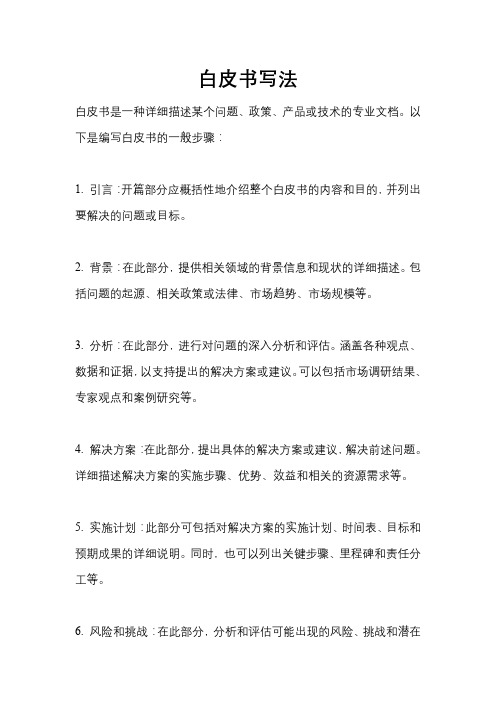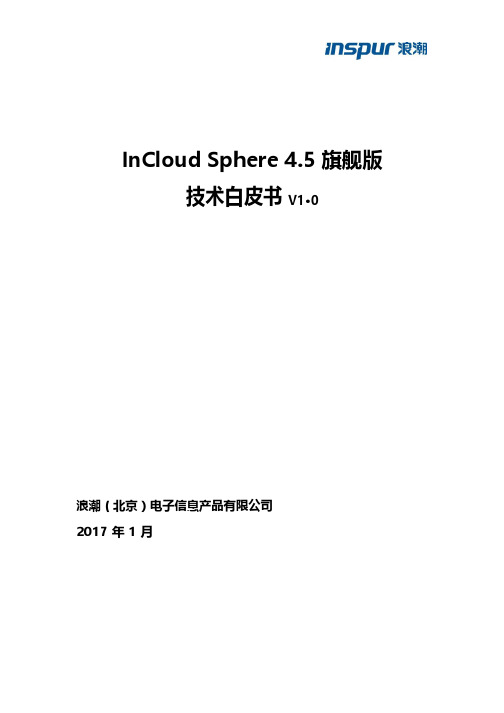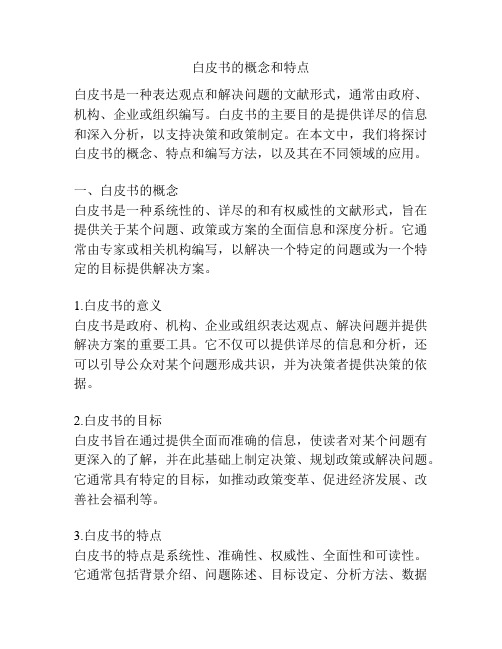商业图表制作白皮书
区块链数字货币白皮书商业计划书PPT模板

“BTC”数字货币白皮书PPT
China Minsheng Bank summary report template
/ 互联网+/商业计划书/ 区块链+/商务演示/
项目负责人:项目总监
目录/CONTENTS
01 区块链的起源 02 我们的团队与公司 03 众筹与私募 04 交易所注意事项
添加标题
55 70 85 40 60 80
请替换文字内容
点击添加相关标题文字,点击添加 相关标题文字。
请替换文字内容
点击添加相关标题文字,点击添 加相关标题文字。
请替换文字内容
点击添加相关标题文字,点击添 加相关标题文字。
请替换文字内容
点击添加相关标题文字,点击添 加相关标题文字。
请替换文字内容
点击添加相关标题文字,点击添 加相关标题文字。
核心成员介绍
姓名:XXX
具有 12 年 Linux/windows 环 境下的 C/C++程序设计开发 经验,熟知 Linux下的网络编 程,POSIX 多线程编程及 STL 编程
姓名:XXX
具有 12 年 Linux/windows 环 境下的 C/C++程序设计开发 经验,熟知 Linux下的网络编 程,POSIX 多线程编程及 STL 编程
02
智能合约
主要基于区块链系统里可信的不可篡改的数据 , 自动地实行一些预先定义好的规则和条款,如新 区块的自动记录。便利快速只能。
03
非对称加密
即在加密和解密的进程中使用一个“密钥对”,“密钥对”中的两个密钥具有非对称的特点,即在信息发送进程 中,发送方通过一把密钥将信息加密,接收方在收到信息后,只有通过配对的另一把密钥才能对信息进行解密。 非对称加密使得任何参与者更容易达成共鸣,将价值交换中的摩擦边界降到最低,还能实现透亮数据后的匿名性, 保护个人隐私
白皮书和商业计划书的区别

白皮书和商业计划书的区别白皮书和商业计划书都是在商业领域中常见的文件。
虽然它们都属于商业文书,但它们在格式、目的和用途上存在一些明显的区别。
本文将重点探讨白皮书和商业计划书之间的区别。
一、格式要求:白皮书的格式通常要求较为自由。
它可以采用大段文字、图表、统计数据等来展示相关问题和解决方案。
一般来说,白皮书没有特定的页数要求,可以根据需要调整篇幅。
而商业计划书则更加具有规范的格式要求。
它通常包括封面、目录、市场分析、产品介绍、财务预测等内容,并且需要按照一定的顺序进行排版。
二、目的和用途:白皮书主要用于解决问题和提供解决方案。
它是一种针对特定问题的详细分析和研究报告,旨在通过专业的研究和分析为决策提供依据。
白皮书通常由专家和学者撰写,涵盖范围广泛,从社会问题到科技话题都有可能。
而商业计划书则主要用于创业或企业经营。
它包含了公司的目标、运营计划、财务预测等内容,是为了向投资者、合作伙伴或金融机构展示商业创意和可行性而准备的。
三、受众群体:白皮书的受众主要是专业人士和决策者。
他们通常对特定领域或问题的研究感兴趣,并希望通过白皮书获得更深入的了解和洞察。
商业计划书的受众则更加广泛,包括投资者、合作伙伴、银行和风险资本家等。
他们希望通过商业计划书了解创业项目的商业模式、市场前景以及投资回报等信息,以便做出决策。
四、内容重点:白皮书强调问题和解决方案的详细分析。
它通常包括对问题的背景、原因和影响的阐述,以及提出的解决方案的具体步骤和效果预测等。
商业计划书更侧重于商业模式和商业运营。
它包括市场分析、产品或服务的介绍、营销策略、财务计划等。
商业计划书需要更加具体和具备可操作性,以便投资者了解创业项目的商业可行性。
综上所述,白皮书和商业计划书在格式、目的、用途、受众和重点内容上存在明显的区别。
了解并正确运用它们能够帮助我们更好地传达信息、解决问题和拓展商业机会。
在编写白皮书或商业计划书时,我们应该根据具体情况选择合适的格式并明确目的,以提高信息传达的效果和影响力,从而更好地实现商业目标。
白皮书课件ppt

校对和修改
对白皮书的内容进行校对和修改,纠正错别字、语法错误等问题。
对内容进行优化和完善,提高白皮书的可读性和专业性。
发布和传播
选择合适的发布渠道,如公司官网、社交媒体等,以扩大 白皮书的传播范围。
制定传播策略,通过多种渠道进行推广和宣传,提高白皮 书的知名度和影响力。
白皮书的目的和作用
总结词
白皮书的主要目的是提供权威信息,以影响和引导公众、商业伙伴或政策制定 者的观点和决策。
详细描述
白皮书的具体目的可能因发布方而异,但通常包括宣传、教育、引导舆论或推 动政策制定等。白皮书的作用在于提供全面、准确的信息,帮助读者了解某个 主题的背景、目的和意义,从而影响其观点和决策。
白皮书课件
• 白皮书概述 • 白皮书编写流程 • 白皮书内容编写 • 白皮书阅读和解读 • 白皮书应用和实践
01
白皮书概述
白皮书的定义
总结词
白皮书是一种官方文件,通常由 政府或大型企业发布,用于阐述 某个政策、项目或产品的重要信 息。
详细描述
白皮书通常具有权威性和正式性 ,旨在提供全面、准确和客观的 信息,帮助读者了解某个特定主 题的背景、目的和意义。
重点阅读
针对白皮书中的重点内容 进行深入阅读,理解其核 心观点和论据。
做笔记
在阅读过程中,及时记录 重要观点、数据和信息, 以便后续分析和整理。
解读技巧
逻辑分析
分析白皮书的逻辑结构, 理解作者的观点和思路, 判断其合理性和可信度。
数据解读
对于白皮书中提供的数据 和图表,要进行深入解读 ,理解其背后的含义和趋 势。
05
白皮书应用和实践
金仓报表技术白皮书

金仓报表工具Kingbase Report 技术白皮书2 目录1.范围 (3)2.产品概述 (3)3.技术架构 (3)4.主要特性 (4)4.1快速应用,简化设计 (4)4.2高效稳定,易于扩展 (5)4.3功能完备,注重体验 (5)4.4多种格式,全面展现 (5)4.5快捷查询,方便监控 (6)4.6配置易用,简便集成 (6)版权声明 (7)1.范围本文档介绍了人大金仓报表工具Kingbase Report的技术特性和功能,主要包括产品技术构架和各项特性等。
这些产品特性和技术指标对企业的开发人员、信息专家以及企业管理者具有一定的参考意义。
本文档所描述的内容适用于金仓报表工具Kingbase Report V2.0。
2.产品概述金仓报表工具Kingbase Report是金仓BI统一平台的重要组成部分,是一款功能强大的企业级报表工具软件,集报表设计器、报表引擎和报表服务器于一体,可运行于跨平台的统一环境中,具有鲜明的中国式报表特色。
金仓报表工具提供了高效的Web报表设计方案、强大的报表展现能力和灵活的部署机制,为企业级统计分析、数据中心、商业智能前端展现提供了高性能、高效率的报表产品解决方案,让企业的开发人员、信息专家、企业管理者能够从容使用,直观全面地从历史的、海量的数据中获取信息,发掘数据的最大价值。
3.技术架构金仓报表工具由四个部分组成:报表设计器、报表引擎、报表服务器和报表客户端。
◆报表设计器设计编辑报表,自带报表运算引擎,连接数据库后可预览打印报表,并可生成其它格式保存。
设计器不依赖于其它部分,可独立工作。
◆报表引擎在后台提供统计报表运算和图表处理的服务,开放各层次的API接口调用,由程序员调用生成结果报表。
引擎运行不依赖设计器。
◆报表服务器作为服务程序运行,包括报表的模板管理、调度管理、服务监控等等。
模板管理可以在运行时添加和删除报表模板;调度管理可以在设定的时刻自动计算报表并将结果保存或推送到指定的目标。
企业白皮书写作技巧

企业白皮书写作技巧企业白皮书是一种重要的商业文件,用于介绍企业的使命、愿景、战略目标和产品或服务。
它具有一定的技巧和要求,以下将重点介绍撰写企业白皮书的一些技巧。
一、确定目标受众在撰写企业白皮书之前,需要明确目标受众。
不同的受众有不同的需求和关注点,所以企业白皮书需要根据不同的读者定位撰写。
目标受众可以是投资者、合作伙伴、潜在客户或政府机构等。
二、明确主题和目的企业白皮书需要明确主题和目的,即要表达什么内容以及为什么要撰写。
主题和目的有助于指导整个白皮书的撰写过程,并确保信息的连贯性和完整性。
三、进行调研和分析在撰写白皮书之前,需要进行充分的调研和分析。
这包括对行业趋势、竞争对手、目标市场和潜在客户的调查,以及对公司内部资源、能力和优势的评估。
调研和分析的结果可以作为白皮书的基础,提供可靠的数据和事实支持。
四、结构合理、内容清晰企业白皮书应具有良好的结构和清晰的内容。
一般而言,可以按照以下结构组织白皮书:引言、背景、问题陈述、解决方案、实施计划、预期成果等。
每个部分应包含明确的标题和适当的分段,以便读者快速浏览和索引。
五、使用易懂的语言白皮书应使用易懂的语言,避免过多的专业术语和行业潜规则的使用。
清晰简洁的语言可以更好地传达信息,并使读者更容易理解和接受。
六、提供可靠和可验证的证据在白皮书中,提供可靠和可验证的证据是非常重要的。
这可以包括调研数据、市场调查、行业报告、用户案例研究等。
这些证据可以支持企业的主张,并增加白皮书的信任度。
七、注重设计和排版企业白皮书的设计和排版也是需要关注的重点。
格式整齐、美观的设计可以提升白皮书的可读性和吸引力。
选择合适的字体、颜色和图表,并确保内容和图像的整体呈现一致和协调。
八、注意审校和校对在完成白皮书的撰写后,需要进行仔细的审校和校对。
拼写、语法和标点符号的错误会给读者留下不专业的印象,并可能导致误解。
同时,检查事实准确性和逻辑结构的连贯性也是十分关键的。
九、呈现优化最后,考虑白皮书的呈现方式。
行业白皮书编制指南

行业白皮书编制指南前言行业白皮书是一种对特定行业进行深入研究和全面分析的重要文献。
它涵盖了行业的发展状况、趋势、挑战和机遇,为决策者、研究者和相关从业者提供了有价值的信息和洞察力。
编制一份高质量的行业白皮书需要科学的方法和系统的步骤。
本指南将为您提供一些有用的建议和指导,帮助您编制一份出色的行业白皮书。
1. 确定目标和受众在开始编制行业白皮书之前,首先需要明确编制白皮书的目标和受众。
确定目标可以帮助您明确您编写白皮书的目的,是为了政策制定、市场分析还是战略规划。
同时,明确受众可以帮助您更好地选择信息和写作风格,以使白皮书更具影响力和可用性。
2. 收集行业数据和信息编制行业白皮书需要大量的行业数据和信息。
您可以通过以下途径收集数据和信息:•市场研究报告:收集最新的市场研究报告,了解行业的基本情况、趋势和关键驱动因素。
•行业统计数据:收集相关的行业统计数据,如销售额、产量、出口额等,以支持您的分析和结论。
•专家访谈:与行业专家进行深入访谈,了解行业内部的情况和见解。
•企业报告:阅读相关企业的年度报告、财务报表和研发报告,了解企业的经营情况和发展策略。
3. 进行行业分析在收集了足够的数据和信息后,您需要对行业进行深入分析。
行业分析可以包括以下几个方面:•市场规模和增长趋势:对行业的市场规模和增长趋势进行详细分析,了解行业的发展潜力。
•竞争格局:分析行业内的主要竞争对手和其市场份额,了解行业的竞争格局和竞争优势。
•关键驱动因素:确定影响行业发展的关键驱动因素,如技术创新、政策支持等。
•机遇与挑战:分析行业的机遇和挑战,如新兴市场、市场准入障碍等。
4. 结合案例分析和实证研究为了使行业白皮书更具可信度和说服力,可以结合案例分析和实证研究。
通过具体的案例和实证数据,可以支持和证明您的观点和结论。
您可以通过以下方式进行案例分析和实证研究:•案例研究:选择行业内的典型案例,深入剖析其成功和失败因素。
•实证研究:选择相关的实证研究,如市场调查、实地观察等,支持您的分析和结论。
行业白皮书资料大全

行业白皮书资料大全随着信息时代的到来,我们所处的世界正飞速发展,各个行业也在不断演变和创新。
对于从业者来说,了解行业的发展动态以及市场趋势非常重要。
行业白皮书是一种全面客观地呈现行业背景、数据、趋势的资料,对于深入了解行业的现状和未来发展方向非常有帮助。
本文将为大家介绍一些常见行业白皮书的资料和信息,希望对你们有所启发。
一、电子商务行业1. 《中国网络零售市场增长白皮书》这本白皮书是中国电子商务研究中心发布的,详细分析了中国电子商务行业的整体发展状况、市场规模、行业结构以及未来的趋势。
它对于电商从业者了解市场状况、调整经营策略具有指导意义。
2. 《全球电商大数据白皮书》这本白皮书由阿里巴巴研究院发布,通过对全球范围内大量的电商数据进行分析,呈现了全球电商行业的发展趋势、国际市场竞争格局以及各个国家的电商特点。
它可以为从事国际电商和跨境电商的企业提供有益的参考。
二、金融科技行业1. 《中国金融科技发展白皮书》这本白皮书由中国互联网金融协会发布,重点关注金融科技在中国的发展,并分析了当前的市场形势以及未来可能出现的机遇和挑战。
它对于从事金融科技行业的从业者和投资者具有重要参考价值。
2. 《全球金融科技创新白皮书》这本白皮书是全球金融科技协会发布的,通过对全球范围内的金融科技创新进行研究和整理,揭示了不同国家在金融科技领域的实践经验和创新成果。
它可以为金融科技企业提供灵感和借鉴。
三、人工智能行业1. 《中国人工智能发展白皮书》这本白皮书由中国人工智能学会发布,系统地介绍了中国人工智能行业的发展现状、政策支持、技术应用以及市场前景。
它对于从事人工智能领域的企业家、科研机构和投资人都非常有价值。
2. 《全球人工智能报告》这本报告由麻省理工学院发布,梳理了全球范围内的人工智能研究和应用情况,并对未来的技术发展和社会影响进行分析。
它为我们了解人工智能的全球趋势和国际合作提供了重要信息。
四、健康医疗行业1. 《中国健康医疗白皮书》这本白皮书是中国健康促进基金会发布的,综合了国内外相关研究成果,介绍了中国健康医疗行业的现状、问题和未来发展方向。
白皮书写法

白皮书写法白皮书是一种详细描述某个问题、政策、产品或技术的专业文档。
以下是编写白皮书的一般步骤:1. 引言:开篇部分应概括性地介绍整个白皮书的内容和目的,并列出要解决的问题或目标。
2. 背景:在此部分,提供相关领域的背景信息和现状的详细描述。
包括问题的起源、相关政策或法律、市场趋势、市场规模等。
3. 分析:在此部分,进行对问题的深入分析和评估。
涵盖各种观点、数据和证据,以支持提出的解决方案或建议。
可以包括市场调研结果、专家观点和案例研究等。
4. 解决方案:在此部分,提出具体的解决方案或建议,解决前述问题。
详细描述解决方案的实施步骤、优势、效益和相关的资源需求等。
5. 实施计划:此部分可包括对解决方案的实施计划、时间表、目标和预期成果的详细说明。
同时,也可以列出关键步骤、里程碑和责任分工等。
6. 风险和挑战:在此部分,分析和评估可能出现的风险、挑战和潜在问题。
提供如何应对这些问题的建议,并对解决方案的可行性进行讨论。
7. 结论:总结之前的所有内容,再次强调解决方案的价值和优点,并针对未来发展提出展望和建议。
同时,也可以在此部分再次呼吁读者采取行动。
8. 参考文献:列出所有引用、参考的来源和文献,确保白皮书的可信度和准确性。
9. 附录:在需要的情况下,可以在白皮书的附录中包含进一步的信息和数据,如图表、调查问卷、技术规格等。
在编写白皮书时,还应注意以下几点:- 结构要清晰,段落之间要有逻辑连接;- 使用简明扼要的语言,避免复杂的专业术语,或者在使用时加以解释;- 重点突出,通过标题、亮点和图表等方式吸引读者的注意力;- 提供具备可行性的解决方案,通过事实和数据来支持提出的观点;- 客观公正,尽可能避免主观色彩和偏见;- 编辑校对,确保白皮书的语法、拼写和格式的准确性。
总之,编写一份优秀的白皮书需要充分研究和准备,清晰地表达问题和解决方案,并用可信的数据和证据来支持观点。
如何制作一份优秀的白皮书?

如何制作一份优秀的白皮书?概述:白皮书,是指为了表达某种观点或者方案,对某种社会问题进行深度分析,提出解决方案的一种文献类型。
在市场营销、政治宣传等领域中被广泛使用。
在互联网时代,白皮书已经成为科技和创新领域中非常重要的一部分。
但是,如何制作一份优秀的白皮书呢?本文将介绍白皮书的几个关键要素:目标受众、问题陈述、解决方案、分析和调查、重要数据、设计和布局、营销和销售。
一、目标受众白皮书是为了解决某个问题而编写的,因此,需要确定目标受众。
目标受众是指需要了解该问题并具有影响力的人,例如:企业主管、学者、媒体人等等。
在确定目标受众时,需要考虑以下几点:1. 目标市场2. 职业背景3. 视觉和听觉水平4. 投资能力二、问题陈述问题陈述是白皮书的核心要素之一,它需要提出并解释所要解决的问题。
问题陈述需要简单清晰,具有说服力。
在撰写问题陈述时,需要注意以下几点:1. 明确问题核心2. 确定问题全貌3. 呈现问题的必要性和实际价值三、解决方案解决方案是白皮书的另一个核心要素,它是为了解决已经提出并解释的问题而提出的方法和建议,需要详细地解释,并能够被实施。
在编写解决方案时,需要注意以下几点:1. 解决方案必须符合实际需求2. 解决方案必须科学合理3. 解决方案必须有实际意义和应用价值四、分析和调查分析和调查是白皮书的判断力量和分析力量的体现,需要对已提出的问题进行深入分析和研究。
调查数据、分析数据,使解决方案更有力、更可行。
在分析和调查时,需要注意以下几点:1. 用数据和图表支持分析结果2. 利用已有的调查结果3. 反应统计学数据的参数和标准差五、重要数据重要数据是白皮书的重要组成部分,是根据分析和调查得出的数据。
它能够对读者进行更好的信息传递和说服力。
在整理重要数据时,需要注意以下几点:1. 数据必须真实准确2. 用清晰的表格和图表展示数据3. 突出数据的关键性六、设计和布局白皮书的外观设计和版面布局对于读者的阅读体验和阅读理解都至关重要。
企业白皮书写作指南

企业白皮书写作指南企业白皮书写作指南引言:企业白皮书是一种高级营销工具,可以帮助企业向潜在客户、合作伙伴和投资者传达关键信息。
它旨在提供对企业的全面了解,包括产品或服务、市场竞争优势、商业模式以及未来发展计划。
本文将分享一些基本原则和指南,帮助企业编写一份引人注目的白皮书。
第一节:确定目标受众在编写白皮书之前,企业需要确定目标受众。
这样可以更好地定位白皮书的内容和风格。
考虑以下问题:1. 白皮书的受众是谁?是潜在客户、合作伙伴、投资者或其他利益相关者?2. 目标受众对于企业的产品或服务了解程度如何?在技术方面是否具有专业知识?3. 目标受众对企业是否有先入为主的印象?是否存在误解或疑虑?根据不同受众的需求,企业可以编写多份白皮书,或者对现有白皮书进行定制。
第二节:确定白皮书的结构一份好的白皮书应该有清晰的结构,包括以下几个部分:1. 封面和目录:简洁清晰地展示企业名称、标志和白皮书主题,方便读者快速导航。
2. 概述:介绍白皮书的重要性和目的,以及企业的背景和愿景。
此部分应该引起读者的兴趣,并促使他们继续阅读。
3. 问题陈述:描述企业现有产品或服务希望解决的特定问题或市场需求。
清晰地定义问题可以帮助读者了解企业的核心竞争力。
4. 解决方案:详细描述企业的产品或服务如何有效解决问题或满足市场需求。
可以提供实际案例或统计数据来支持解决方案的有效性。
5. 商业模式:解释企业的商业模式,包括收入来源、渠道模式、合作关系等。
这有助于读者了解企业的盈利能力和长期可持续发展性。
6. 营销计划:展示企业的市场推广策略、目标客户群体、竞争优势和销售预测。
这部分可以增加读者对企业未来发展的信心。
7. 投资计划:如果目标受众是投资者或潜在合作伙伴,应该提供关于企业融资需求、投资回报以及股权结构的明确说明。
8. 附录:提供相关支持材料,如统计报告、研究结果、实施计划等。
这些材料可以帮助读者更好地理解企业的价值和竞争优势。
WPS Office 2016 产品白皮书

WPS Office2016产品白皮书Fo r Wi n d o w s2015年11月目录1WPS Office2016产品简介.........................................................................................1.1深度兼容,轻松过渡......................................................................................1.2云端办公,随心工作......................................................................................1.3文档安全,自主可控......................................................................................1.4精致高效,稳定可靠...................................................................................... 2WPS Office2016核心技术简介.................................................................................2.1四层柔性架构体系..........................................................................................2.2自主开发四大核心引擎..................................................................................2.2.1文字排版引擎.......................................................................................2.2.2演示动画引擎.......................................................................................2.2.3表格计算引擎.......................................................................................2.2.4图形绘制引擎.......................................................................................2.3数据接口.......................................................................................................... 3WPS Office2016功能亮点.........................................................................................3.1通用功能..........................................................................................................3.1.1界面切换...............................................................................................3.1.2输出PDF格式......................................................................................3.1.3窗体工具和控件...................................................................................3.1.4文档标签...............................................................................................3.1.5入口导航...............................................................................................3.1.6图片处理工具.......................................................................................3.1.7自定义符号栏.......................................................................................3.1.8文档安全...............................................................................................3.1.9备份管理...............................................................................................3.1.10兼容设置.............................................................................................3.1.11支持2D、3D效果..............................................................................3.1.12艺术字效果.........................................................................................3.1.13在线资源服务.....................................................................................3.2WPS文字2016...............................................................................................3.2.1文字工具...............................................................................................3.2.2段落布局...............................................................................................3.2.3章节导航...............................................................................................3.2.4快速表格...............................................................................................3.2.5表格计算...............................................................................................3.2.6文字方向...............................................................................................3.2.7文档结构图...........................................................................................3.2.8绘制斜线表头.......................................................................................3.2.9文档稿纸格式.......................................................................................3.2.10文本框链接.........................................................................................3.2.11邮件合并.............................................................................................3.2.12自定义水印.........................................................................................3.2.13PDF阅读..............................................................................................3.3WPS演示2016...............................................................................................3.3.1对象属性...............................................................................................3.3.2动画效果...............................................................................................3.3.3幻灯片模板...........................................................................................3.3.4幻灯片母版...........................................................................................3.3.5“魔法”一键美化...............................................................................3.3.6幻灯片库...............................................................................................3.3.7演示工具...............................................................................................3.3.8放大镜功能...........................................................................................3.3.9放映时添加墨迹...................................................................................3.3.10双屏演示.............................................................................................3.3.11插入多媒体文件.................................................................................3.3.12自定义放映设置.................................................................................3.3.13手机遥控.............................................................................................3.4WPS表格2016...............................................................................................3.4.1模拟分析...............................................................................................3.4.2函数计算...............................................................................................3.4.3共享电子表格.......................................................................................3.4.4阅读模式...............................................................................................3.4.5人民币大写...........................................................................................3.4.6状态栏多重汇总...................................................................................3.4.7编辑栏...................................................................................................3.4.8数据排序...............................................................................................3.4.9多重筛选...............................................................................................3.4.10录入数据控制.....................................................................................3.4.11条件格式.............................................................................................3.4.12数据粘贴数值运算.............................................................................3.4.13函数和公式.........................................................................................3.4.14数据图表.............................................................................................3.5WPS+云服务....................................................................................................3.5.1什么是WPS+一站式云办公服务........................................................3.5.2WPS+统一帐号......................................................................................3.5.3WPS云文档........................................................................................... 4WPS Office2016的典型扩展应用..............................................................................4.1WPS Office与办公系统的集成应用..............................................................4.2新办公模式中的统一文档处理平台..............................................................4.3统一文档资源管理和软件管理......................................................................4.3.1办公软件管理.......................................................................................4.3.2内网资源管理...................................................................................... 5产品二次开发相关......................................................................................................5.1WPS Office程序对象的创建与获取............................................................5.2二次开发概述与示例......................................................................................5.2.1VBA开发...............................................................................................5.2.2调出式开发...........................................................................................5.2.3嵌入式开发...........................................................................................5.2.4生成式开发...........................................................................................5.2.5插件式开发........................................................................................... 6WPS Office2016版本说明......................................................................................... 7WPS Office2016运行环境.........................................................................................附:WPS Office产品历史简介....................................................................................1WPS Office2016产品简介自1989年WPS1.0问世以来的二十年间,WPS办公软件从单一的文字处理软件逐渐充实为集文字处理、电子表格、电子演示为一体的信息化办公平台。
白皮书结构

白皮书结构
白皮书通常由以下几个部分组成:
1. 概述:介绍白皮书的主题和目标,概括性地解释为什么这个主题很重要以及该白皮书对读者的意义。
2. 背景和问题陈述:讨论当前问题或挑战,并提供相关的背景信息和数据支持,解释为什么解决这个问题是至关重要的。
3. 目标和解决方案:明确阐述该白皮书的目标,并详细描述解决这个问题的方法、策略或技术。
这个部分通常涵盖一些技术、理论或模型的描述和解释。
4. 实施计划:提供一个详细的步骤或计划,说明如何实施解决方案。
这可能包括时间表、资源需求、合作伙伴关系、风险评估等。
5. 成功案例或证据支持:列举先前实施该解决方案的成功案例、实证研究、数据统计等,以增加读者对该解决方案的信心。
6. 风险和挑战:讨论可能面临的风险、挑战或限制因素,以及解决这些问题的策略或对策。
7. 结论:总结该白皮书的主要论点和结果,并强调解决方案的有效性和重要性。
8. 建议和推动:根据该白皮书的内容,提出一些建议或推动行
动的方式,以促进该解决方案的实施和推广。
9. 参考文献:列出该白皮书中所引用的参考文献或支持资料的清单,便于读者进一步了解相关信息和进行进一步研究。
此外,白皮书还可以包括附录、图表、表格等辅助材料,以帮助读者更好地理解和分析问题。
整体结构应该清晰、逻辑严谨,以便于读者阅读和理解。
浪潮 InCIoud Sphere 4.5旗舰版技术白皮书说明书

InCloud Sphere 4.5 旗舰版技术白皮书V1.0浪潮(北京)电子信息产品有限公司2017 年 1 月InCloud Sphere 4.5 旗舰版技术白皮书 V1.0目录1第一章摘要 (5)2第二章InCloud Sphere 产品概述 (6)2.1InCloud Sphere 介绍 (6)2.2InCloud Sphere 架构 (8)3第三章InCloud Sphere 技术原理 (9)3.1InCloud Sphere 系统设计 (9)3.2InCloud Sphere 核心技术 (11)3.2.1CPU 虚拟化 (13)3.2.2内存虚拟化 (15)3.2.3I/O 设备虚拟化 (17)4第四章InCloud Sphere 功能原理 (19)4.1 计算 (19)4.1.1CPU 管理 (19)4.1.2内存管理 (19)4.1.3GPU 管理 (20)4.2 存储 (23)4.2.1 存储I/O (23)4.2.2 快照 (24)4.2.3存储多路径 (25)4.2.4存储读缓存技术 (26)4.3 网络 (26)4.3.1网络虚拟化架构 (26)4.3.2网卡绑定 (29)4.3.3QOS (33)4.4高可用 (33)4.4.1vMotion (33)4.4.2Storage vMotion (36)4.4.3 HA (38)4.5负载均衡 (41)4.6 监控 (44)4.6.1性能收集 (45)4.6.2配置性能图表 (46)4.6.3自动化告警机制 (46)4.7vApp (48)4.8 灾备 (49)4.8.1DR 结构 (49)4.8.2DR 工作原理 (50)4.8.3DR 故障转移 (50)4.8.4备份机制 (51)4.9 容器 (52)4.9.1Docker 介绍 (52)4.9.2InCloud Sphere 旗舰版和Docker (52)4.9.3InCloud Sphere 提供Docker 支持优势 (54)5第五章InCloud Sphere 自动化能力 (56)5.1自动化安装 (56)5.1.1自动化部署架构 (56)5.1.2自动化部署条件 (56)5.1.3自动化部署过程 (57)5.1.4应答文件 (57)5.2自动化更新 (57)5.2.1iCenter 自动检查可用更新 (57)5.2.2Hotfix 自动更新 (58)5.2.3InCloud Sphere Tools 自动更新 (59)5.2.4池滚动升级 (59)6第六章InCloud Sphere 开放性和安全性 (61)6.1XAPI (61)6.1.1XAPI 介绍 (61)6.1.2XAPI 功能 (62)6.1.3XAPI 架构 (62)6.2Introspect API (63)6.2.1Introspect API 介绍 (63)6.2.2虚拟机内存保护 (63)6.2.3预防攻击技术 (63)6.2.4虚拟机无代理保护 (64)6.2.5Direct Inspect API 防病毒架构 (64)6.2.6Direct Inspect API 防病毒的优势 (65)6.3PlugIn (65)6.3.1PlugIn 介绍 (65)6.3.2PlugIn 优势 (66)6.3.3部分PlugIn 插件列表 (66)6.4安全架构 (66)6.5SSR (67)6.5.1SSR 介绍 (67)6.5.2SSR 实现原理 (68)6.5.3SSR 技术架构 (69)6.5.4SSR 主要功能 (70)6.6与OpenStack 集成 (70)6.6.1OpenStack 介绍 (70)6.6.2InCloud Sphere 旗舰版的优势 (70)6.6.3与OpenStack 集成架构图 (71)7第七章总结 (73)8第八章缩略语 (74)1第一章摘要浪潮,着力推动中国“行业云”,致力于成为中国领先的云计算解决方案供应商,业已形成涵盖IaaS、PaaS、SaaS 三个层面的整体解决方案服务能力。
标准白皮书

标准白皮书标准白皮书是一种详细的技术和商业规划文件,在加密货币和区块链行业中使用广泛。
它旨在向潜在投资者和利益相关者提供有关该项目的全面信息。
以下是撰写标准白皮书时的一些参考内容:1. 背景介绍:说明项目的起源和目的,以及为什么选择使用区块链技术。
2. 问题陈述:期间探讨项目作为解决方案的重要性,提出市场上存在的难题和问题。
3. 解决方案:详细介绍项目如何利用区块链技术来解决上述问题。
说明项目的独特卖点和竞争优势。
4. 技术架构:描述项目所采用的技术架构、算法和协议。
解释为什么选择了这些技术,并讨论其可行性和安全性。
5. 经济模型:解释项目的经济模型,包括代币发行和分配方式,代币的用途和功能,以及具体的经济激励机制。
6. 市场分析:进行市场调研,分析项目的目标市场和竞争对手。
提供数据和图表支持,以展示市场潜力和增长预测。
7. 发展计划:列出项目的发展阶段和时间表。
详细说明项目的路线图,包括开发、测试、部署和营销计划。
8. 团队成员和顾问:介绍项目团队的成员和关键顾问。
说明他们的背景、技能和经验,并强调他们在该领域的专业知识。
9. 社区建设:讨论项目的社区建设计划,包括如何吸引用户和支持者。
提及社交媒体渠道和活动,以及市场推广策略。
10. 风险与合规性:评估项目可能面临的风险,并提供相应的风险管理策略。
同时,强调项目的合规性和法律遵从性。
11. 资金用途和筹款计划:详细描述项目的资金用途,解释筹款计划和资金分配。
提供透明的财务数据和预算。
12. 里程碑和成就:强调项目已经取得的里程碑和成就。
提供具体的数据和统计,证明项目的成功和可行性。
13. 媒体和合作伙伴:列出项目得到的媒体报道和合作伙伴,展示其与行业内其他重要参与者的关系。
14. 法律声明:附上法律声明,确保白皮书内容的准确性和合法性。
提供任何必要的法律声明和免责条款。
以上是一个标准白皮书可能包含的参考内容列表。
根据具体项目的不同,还可以添加其他相关章节和信息。
white paper写法

white paper写法全文共四篇示例,供读者参考第一篇示例:白皮书(White Paper)是用来阐释某一特定问题,提供解决方案或者表达某种观点的一种文体。
白皮书可以用于政府部门、企业组织以及行业协会等不同领域,通常用来传达专业知识,引导公众理解,解决问题和建议政策。
白皮书的写作一般包括以下几个要素:问题描述、提出解决方案、分析论证以及结论和建议等。
下面我们来详细介绍一下白皮书的写作要点。
白皮书的写作应该从一个清晰而具体的问题开始,为读者提供一个明确的背景,使他们对所阐述的问题有一个清晰的认识。
在问题描述的部分,作者可以使用数据、案例或者研究来印证该问题的存在性,并突出其重要性和紧迫性。
接着,提出解决方案是白皮书的重点内容。
作者需要对问题进行深入分析,提出可行的解决方案,并详细说明其原理和实施方法。
在这一部分,作者需要强调解决方案的可行性和有效性,突出这个解决方案相对于其他方案的优势。
在对解决方案的提出之后,作者还需要进行分析和论证,以充分证明所提出的解决方案的可行性和有效性。
作者可以引用专家观点、研究成果、数据统计等来支持自己的观点,使得白皮书更加具有说服力和权威性。
作者需要总结结论并提出建议。
在作者可以对所提出的解决方案进行总结,并强调其重要性和实施意义;在建议部分,作者可以提出具体的实施计划、政策建议或者行动措施,以便读者能够进一步参与和落实解决方案。
在写作过程中,作者还需要注意以下几点:白皮书要求作者具有较强的专业知识和研究分析能力,因此需要认真准备和深入研究所述问题。
白皮书的写作需要简洁明了,尽量避免使用复杂的术语和难懂的句子,使得读者能够轻松理解内容。
白皮书的结构要清晰,逻辑性强,便于读者阅读和理解。
通过以上介绍,相信大家对于白皮书的写作要点有了更清晰的认识。
在写作过程中,需要认真准备,深入分析问题,提出解决方案并进行充分论证,并最终总结结论和提出建议。
希望以上内容对大家写作白皮书有所帮助。
白皮书的概念和特点

白皮书的概念和特点白皮书是一种表达观点和解决问题的文献形式,通常由政府、机构、企业或组织编写。
白皮书的主要目的是提供详尽的信息和深入分析,以支持决策和政策制定。
在本文中,我们将探讨白皮书的概念、特点和编写方法,以及其在不同领域的应用。
一、白皮书的概念白皮书是一种系统性的、详尽的和有权威性的文献形式,旨在提供关于某个问题、政策或方案的全面信息和深度分析。
它通常由专家或相关机构编写,以解决一个特定的问题或为一个特定的目标提供解决方案。
1.白皮书的意义白皮书是政府、机构、企业或组织表达观点、解决问题并提供解决方案的重要工具。
它不仅可以提供详尽的信息和分析,还可以引导公众对某个问题形成共识,并为决策者提供决策的依据。
2.白皮书的目标白皮书旨在通过提供全面而准确的信息,使读者对某个问题有更深入的了解,并在此基础上制定决策、规划政策或解决问题。
它通常具有特定的目标,如推动政策变革、促进经济发展、改善社会福利等。
3.白皮书的特点白皮书的特点是系统性、准确性、权威性、全面性和可读性。
它通常包括背景介绍、问题陈述、目标设定、分析方法、数据和证据收集、解决方案、实施建议等内容,以提供全面而有针对性的信息。
二、白皮书的特点白皮书作为一种特定的文献形式,具有以下特点:1. 详尽深入:白皮书通过全面搜集和分析相关信息,提供详细解读问题的背景、现状和发展趋势。
它涵盖的内容包括政策背景、相关研究、案例分析、数据统计等,以提供全面且深入的了解。
2. 权威可信:白皮书通常由权威专家或机构编写,具有一定的权威性和可信度。
它的内容经过严格的筛选、审查和论证,以确保其准确性和可靠性。
3. 问题导向:白皮书围绕特定的问题或目标编写,其内容主要聚焦于问题的定义、原因分析和解决方案。
它旨在通过深入的分析和系统的论证,为决策者提供解决问题的思路和方法。
4. 政策导向:白皮书通常与政策相关,包括政策的制定、改革和评估。
它提供了有关政策的背景信息、实施效果和可行性研究,为政策决策者提供支持。
产品白皮书模板

产品白皮书模板一、产品概述。
产品白皮书是一份全面介绍产品的文档,旨在为潜在用户和投资者提供清晰、详尽的产品信息。
本白皮书旨在全面介绍我们的产品,包括产品的定位、功能特点、市场前景等内容,希望能够为广大读者提供全面、清晰的了解。
二、产品定位。
我们的产品定位是为了解决用户在日常生活中遇到的问题,提供便捷、高效的解决方案。
我们致力于打造一款用户体验极佳的产品,让用户在使用过程中能够感受到便利和舒适。
三、产品功能特点。
1. 便捷快速,我们的产品拥有快速的响应速度和便捷的操作流程,让用户能够轻松完成各种操作。
2. 多样化选择,产品提供丰富的功能和服务,满足用户多样化的需求,让用户能够根据自身需求进行选择。
3. 安全可靠,产品采用先进的安全技术和严格的数据保护措施,确保用户信息安全可靠。
四、市场前景。
随着科技的不断发展和人们生活水平的提高,市场对于高品质、便捷的产品需求日益增加。
我们的产品将会在这样一个大环境中迎来广阔的市场前景,我们有信心能够在激烈的市场竞争中脱颖而出。
五、产品优势。
1. 技术优势,我们拥有一支技术精湛的研发团队,能够不断推出具有创新性和领先性的产品。
2. 用户体验,我们注重用户体验,不断优化产品界面和交互设计,让用户能够享受到流畅、舒适的使用体验。
3. 服务优势,我们提供全天候的客户服务,确保用户在使用过程中能够得到及时的帮助和支持。
六、产品发展规划。
我们的产品将会不断进行更新和升级,以适应市场需求和用户需求的不断变化。
我们将会不断推出更多功能和服务,提升产品的竞争力和用户满意度。
七、总结。
通过本白皮书,我们希望能够向各位读者全面介绍我们的产品,让大家对我们的产品有一个清晰的了解。
我们将会不断努力,为用户提供更好的产品和服务,让用户能够享受到更加便捷、高效的生活体验。
感谢大家的关注和支持!。
白皮书格式

白皮书格式
1 什么是白皮书?
白皮书是一种宣传文件,从企业营销、商业研究到制定政府政策,都非常普遍地使用。
它可用于吸引投资、展示项目和企业以及提出对
当前问题的建议。
白皮书由文本和图表组成,文本部分简要介绍了相
关的背景和概况,着重叙述了要实现的概念、计划、解决方案或项目
的特色。
2 白皮书格式
白皮书格式通常分为以下几个部分:
(1)封面:一般会简单的介绍项目的名称和企业的背景和资质等
信息。
(2)项目介绍:介绍项目的背景,说明它涉及哪些市场或行业,
以及它为什么重要。
(3)企业介绍:包括公司及其团队、企业文化以及使命等重要信息。
(4)产品和技术:介绍项目此功能、项目此使用的技术的相关信息。
(5)市场考察:介绍对项目此的竞争分析、市场潜力及增长速度
等情况。
(6)解决方案:详细介绍解决方案,把握问题及该项目如何解决。
(7)结论:总结结论,反复强调项目此所包含的问题,给出建议
及观点等内容。
3 白皮书的重要性
白皮书作为企业或项目介绍的宣传文件,有着重要的意义。
它既
可以吸引投资者,也可以展示企业的情况,提出新的解决方案,并深
入讨论关键的问题。
除此之外,正式的白皮书能够起到实质性的领导作用,可以催生
全新的领域,使得众多观众看到更多的可能性,从而得到更大的变革
和帮助。
因此,白皮书不仅应用于商业活动,也是政府、企业等在制定策
略方面所不可或缺的重要文件。
商业计划白皮书

商业计划白皮书是一种详细的商业计划,它包含了商业项目的基本概念、目标、策略、运营方式等内容,主要用于向投资人、合作伙伴、政府机构等展示项目的整体规划和前景。
商业计划白皮书的主要内容包括:
1. 项目概述:介绍项目的背景、目的、意义和商业模型。
2. 市场分析:分析行业趋势、竞争对手、目标客户和市场规模等。
3. 产品或服务介绍:详细描述产品或服务的特性、优势和价值。
4. 营销策略:制定有效的市场推广和销售策略。
5. 运营管理:介绍项目团队的组成、职责和管理机制。
6. 财务预测:预测项目未来的收入、支出和盈利状况。
7. 风险评估:评估项目可能面临的风险和应对策略。
8. 投资计划:介绍项目所需的资金、用途和回报等。
9. 附录:提供相关的数据、图表和技术细节等支持性材料。
商业计划白皮书是吸引投资人和合作伙伴的重要工具,也是项目获得政府支持和贷款的必要文件之一。
因此,编写一份高质量的商业计划白皮书对于项目的成功至关重要。
教你制作更好的白皮书

教你制作更好的⽩⽪书⽩⽪书长久以来⼀直都是销售线索的重要来源,并具有思想领导地位,在⼯业⾏业中具有宣传品牌的作⽤。
有效的⽩⽪书可以提供相关的、教育性的内容,帮助⽬标买家解决问题,做出更多信息的商业决策,根据线索、对市场的影响、思想领袖的领导地位、公司全⽅位的品牌认知,得出更有效的结果。
但现在市场上仍然充斥着构思拙劣的⽩⽪书。
有⼀些⽩⽪书只将销售⼿册改头换⾯,缺乏可信的例证或有说服⼒的论点,⽽说服⼒却是⽩⽪书的重要⽬标。
为了帮助你制作出有效的⽩⽪书,达成⽬标,我们已经列出了以下⼏个要点。
辨别你的受众。
你的受众属于哪⼀种类型,执⾏型、分析型、技术型还是三者的结合体?这个问题的答案将帮你决定你的话题和⽅.辨别你的受众。
法。
执⾏型的受众关⼼的是他能得到的最⼤的利益和投资回报。
分析型的受众关注的是如何解决公司的问题或者技术问题。
技术型的受众在乎的是所提出的解决⽅法是否适⽤于他们公司的具体环境,这样的具体细节。
选择那些对受众很重要的话题。
通过问卷调查是了解顾客想法的⼀个很好的⽅式。
⼀个简单的问卷调查,如:⾏业中困扰你的是什.选择那些对受众很重要的话题。
么问题,{是⼯作还是⾓⾊}?或者:“你想在⾏业的新产品中看到什么?{技术标准或科技的进步}”,你的销售团队和⽀持团队可能有好主意,因为他们和客户接触紧密。
使⽤可接受的⽅法制作⽩⽪书。
下⾯是⼏种最常见的⽅法:.使⽤可接受的⽅法制作⽩⽪书。
. 执⾏简报——⼀个简短的、对特定市场、问题及产品的⾼度概括. 商业利益——⾮技术型受众如何受益. 技术概述——给技术受众提供⽅法或产品和服务. 竞争审查——讨论竞争之列的产品和服务的优缺点,意在指出哪个才是最好的选择(对于写⽩⽪书的第三⽅来说,是最好的选择). 评估者的指导——为在购买过程中的决策者提供重要功能及特点的解释。
. 意见书——基于事实和观点的基础上,举出解决某个⾏业具体问题的案例. 专题报导——为特定受众,提供热点或具有争议问题的⼤致解决⽅案组织⼀个进程和审阅⼩组。
- 1、下载文档前请自行甄别文档内容的完整性,平台不提供额外的编辑、内容补充、找答案等附加服务。
- 2、"仅部分预览"的文档,不可在线预览部分如存在完整性等问题,可反馈申请退款(可完整预览的文档不适用该条件!)。
- 3、如文档侵犯您的权益,请联系客服反馈,我们会尽快为您处理(人工客服工作时间:9:00-18:30)。
How to Choose the Right Business ChartA 3-step TutorialSUMMARYThere are 3 fundamental rules that you should always follow whendeciding which chart to use. If you learn these 3 rules, there is a goodchance that you will get it right no matter what the context of your data is.1.OrientationWill I display time-related data?2.TaskWhat message do I want to deliver?3.ShapeWhat type of data am I trying to visualize?In this tutorial, we will explain each of these three steps in detail andillustrate them with practical examples.Most business charts can be either horizontally or vertically oriented. Your first decision when creating a chart should always be whether to display data categories horizontally or vertically.Let’s focus on most frequent business charts, such as column and bar charts, line and area charts, dot plots or pin charts, waterfalls, variance charts, etc. Here’s how you s hould make your decision:TIME - horizontalUse horizontal charts for time series STRUCTURE - vertical Use vertical charts in all other casesTIME – horizontal charts This means that your data categories are years, quarters, months, weeks, days or date/time values. That’s it. In charts, time should always run from left to right , never from top to bottom. It’s a simple convention that everybody understands. Of course you can visualize other types of data categories with horizontal charts. But you will probably run into problems with labelling, category spacing, etc. If you really want to make an exception to this rule, do it only when the number of data categories is very small and their labels(names) are very short.STRUCTURE – vertical chartsWhen you have discrete items (categories orstructure data like products, customers,accounts,… ), use vertically oriented charts,such as vertical Bar chart, vertical Dot chart,vertical Waterfall chart or vertical Circle(Bubble) chart.Vertical charts have two advantages overhorizontal charts:1. It is easier to display category labels2. You can insert them into tables thus creatingcombined table-chart reportsOther chart orientationsCharts can also have circular (polar) orientation, such as pie chart or “spider” (radar) chart. On top of that we also have 2- or even 3-dimensional charts orthogonally oriented in two-dimensional space, for example scatter plots (XY charts) or bubble charts.Here is a summary of all possible chart orientations and when to use them: Orientation When do I use it?1. Horizontal Use only when your data represents time series (years,quarters, months, weeks, days or date/time values2. Vertical Use if you have discrete items (categories or structuredata, such as products, customers, accounts, )3. Circular Avoid circular (polar) charts like pie-chart or radar(spider) chart whenever possible. Use pie-chart only whenthe number of categories is very small (2 or 3 categories) 4. 2D Use when you have 2 or 3 variables in your data, such asin bubble charts or scatter plotsMost BI/reporting/visualization tools offer a large set of chart types to choose from. So it is utterly important that you understand and predict the nature of the analytical task that your readers will perform when observing your charts. Ask yourself: What message am I trying to convey?For example, you might simply want to show an interesting trend overtime. Or enable your readers to compare sales values of different products.Yet another time your readers will need to understand the variance tobudget, growth from previous year values, contribution of specificproducts’ variance to the total variance, etc.Here is our cheat sheet that will help you select the right chart for most common tasks that business users typically perform: STRUCTURE ANALYSIS (CATEGORY COMPARISON)Structure analysis is the most basic analytic task where the reader observes the displayed values and visually compares data categories to each other.These comparisons are usually of the following nature:1.Looking up a specific value (e.g. finding the sales value of a specificproduct)paring two values between each other3.Ranking (trying to establish the sequential order of one or more datacategories)4.Recognizing patterns in the data (outliers or subsets of values with aspecific pattern)Whenever you display categories like this, think about the order ofcategories. For ranking, sort categories by value. In other cases ordercategories by their importance or perhaps a natural order like geography.Do not use alphabetical order – it works for phone books only …TIME-SERIES (TREND) ANALYSISTime series (trend) analysis is a similar task to structure analysis butperformed when the data categories represent time (years, quarters,months, weeks, days, timestamps).Depending on the situation, the reader will perform the following types of comparisons within the displayed time series:1.Looking up a specific value (e.g. the sales value of the last month)paring two values between each other3.Observing trends in the data (subsets of values with a specific pattern,e.g. linear growth or other type of seasonality)PART-TO-WHOLE COMPARISONHere users try to assess the relation of a part to the whole value (e.g.sales of one product to total sales of the company). The analysis exposes the “significance” of each part relative to the total value. Use stacked bar charts for part-whole comparison (and OK, pie charts as well, but only in very limited cases!):Avoid using pie charts altogether. They only work for verysmall number of categories (1-2). In fact, they actuallywork best when you only display 1 category compared tothe whole (as in the example above). Guess what, it’s calledthe “pac-man” chartVARIANCE ANALYSISVariance analysis is the most fundamental task in business reporting. Understanding deviations from targets or budgets and growth rates from previous periods is a core requirement in almost any organization. Use “plus-minus” charts to show variance over time or over structures:Use “integrated variance” charts to display actual values as well as deviations. Since both values (actual and deviation) are shown, the user can evaluate both the importance of each deviation (its magnitude) as well as its relative share of actual value at the same time:Variance charts are the key ingredientof successful business reports. Focus onchanges and deviations!CONTRIBUTION ANALYSISContribution Analysis is a special type of part-to-whole analysis to assess the contribution of all parts to the whole value. There are two main versions of Contribution Analysis: (1) Contribution of variances and (2) Contribution of categories. Use waterfall chart for contribution analysis, it is simply perfect for showing explanations why a total value has changed. Here are 4 typical examples:Waterfall chart is also called the “bridge” chart for obvious reasons. Waterfall chart is a perfect visualizationfor contribution analysis.CORRELATION ANALYSISCorrelation analysis is used to assess whether two variables are correlated. It is also suitable for spotting outliers. Use scatter plot for correlation analysis:If two variables are in correlation, thisdoes not necessarily mean that there isa cause & effect relationship betweenthem!PORTFOLIO ANALYSISTo analyze a portfolio of data categories (e.g. products, customers, suppliers, plants, etc.) by 3 variables, use the bubble chart:Once you have determined the correct chart orientation and the intended task of your visualization, you are ready for your last major decision: which chart shape should I use?Instead of always just using the identically looking “default” column chart regardless of what it actually represents, you should use different chart shapes for different types of values (KPIs). This is called shape coding:For example, the columns in the Price chart are much thinner than the ones in the Revenue chart. This is quite intuitive – revenue values are usually way bigger than prices since price is actually a ratio of revenue, divided by quantity (a value/volume division). Similarly you can use“pin” charts(yes, the “lollypops” ) for percentages since they are value/valueor volume/volume divisions and are thus without any unit (just indexes, %). So it seems intuitive to use chart shapes without width for indexes in business reporting. Once readers understand this, they will instantly know what they are looking at, even without reading the labels. Especially in a repeating process, such as monthly reporting.Instead of always using the defaultcolumn chart, use different chart shapesfor different KPIs.Similarly you can use patterns to code data scenarios like Actual, Budget, Forecast and Previous Year. For example, here is how budget values can look like:Check out IBCS (International Business Communication Standards) for more great ideas like this.Achieving consistency in business reporting is critical! It is relatively easy to select the perfect chart shape when you only have one chart. That’s not rocket science and many researchers an d authors have written guidelines on how to do this. But business reporting is so much more than just designing one single chart. In fact, most times you will have to use several charts at once to get the full message across to your readers.Often you’ll n eed to design a report with many pages, a BI dashboard with several screens, etc. This is when consistency in your design becomes of utter importance.Just as traffic signs consist of consistent colors and shapes that always mean the same thing, elements in business reports should be consistently designed to depict or “code” the same meaning with always the same shapes, colors, patterns, etc.Same colors and shapes always meanthe same thing in traffic signs. Soshould they in your reports,presentations or dashboards!Emphasize single values or trend?The shape of a chart itself determines what we will see and how we will interpret the numbers. Several “gestalt” laws govern our vis ual perception. That’s a fact. Different chart shapes will convey different messages to your audience .For instance, some charts are more suitable for emphasizing single values, while others are better at displaying trends. Let’s illustrate this with the following examples:While we can see theoverall trend, the verticaltendency and clearindication of barheights support us incomparing singlevalues (compare heightsbetween two singlevalues, such as Jul to Augor Nov to Dec).Use this chart shape whenthe number of periods issmall and only when thechart is big enough. The flow of the line emphasizes the trend, while the dots mark the height of a single value. There is much more emphasis on the continuation or the flow of the values (trend analysis), but still some support for single value comparisons.There is no explicit graphical support for single value comparisons, making it very hard to estimate the differences between particular months. What is left is the continuity of the line, clearly exposing the trend in the data.Use bars for value comparisons,use lines to reveal trends.So, the perception of different chart shapes is clearly ordered from vertical bars (“columns”) to more “horizontally” oriented lines:Still puzzled which shapes to use?OK, here are two rules of a thumb:e chart shapes on the left when single values are important (e.g.annual or monthly figures) and when you expect that users will compare values between each other (e.g. current month to previous month). Also note that this is only meaningful when charts are big enough that you can comfortably display the columns and labels.e chart shapes on the right when you want the users to focus onoverall trends. Also, choose line charts when you’re limited with space(e.g. small char t sizes, small category widths, …).Just remember, before you click to insert your perfect chart, think about the 3 fundamental rules!Liked this article? Share the knowledge!About Zebra BIZebra BI is an Excel Add-in that enables you to create professional charts, reports and dashboards within Excel in just a few clicks.Create advanced charts in just 2 clicks… directly within ExcelVariance charts, “Waterfalls”, “Hills&Valleys”, “Lollipops” and much more. The 22 business charts that you need for professional reporting.No training required, no programming, no formulas.。
